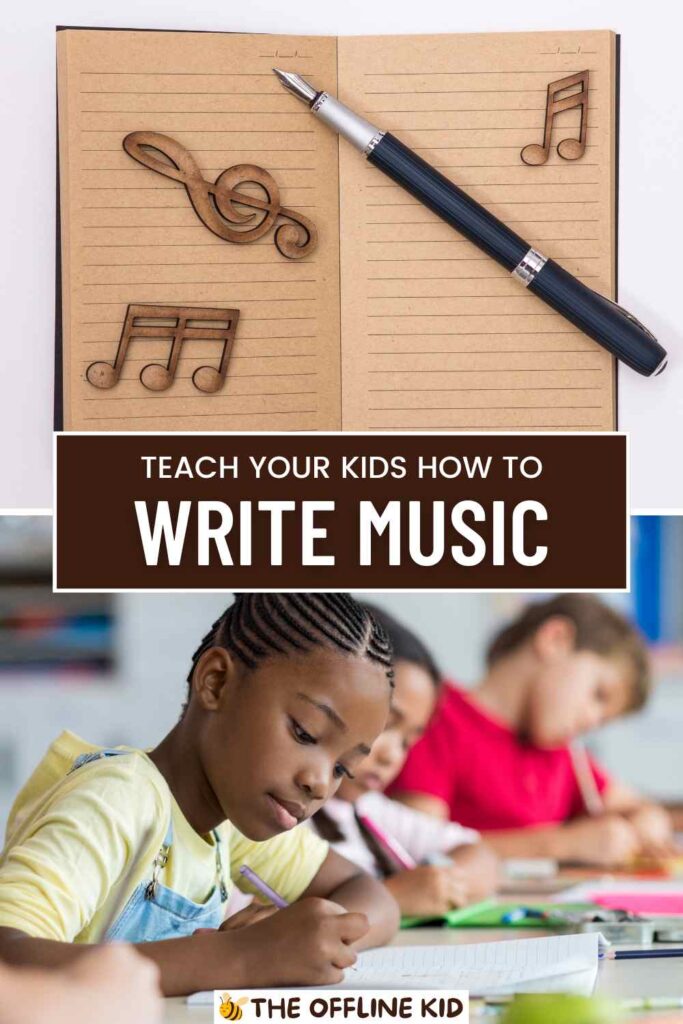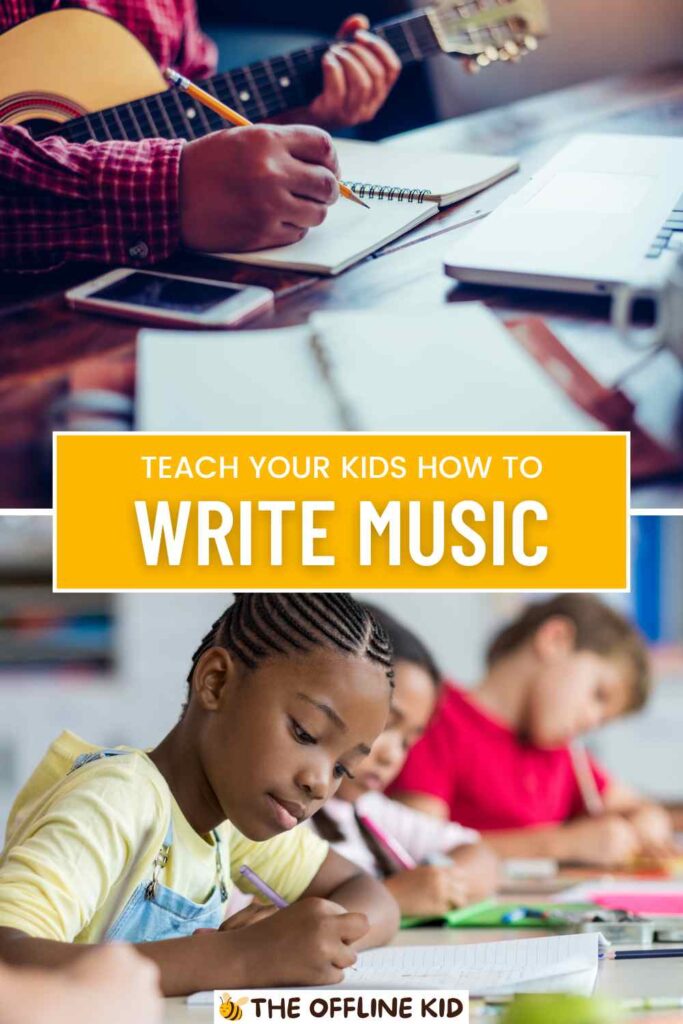Writing music with kids is an exciting journey full of wonder, discovery, and creativity.
Whether you’re a parent, teacher, or caregiver, this unique bond creates lasting memories while nurturing critical life skills.
Dive into a world where melodies meet playful imagination, and watch your little composers flourish. Join the fun!
The Joy of Creating Songs Together
Bringing children into the songwriting process offers a whirlwind of excitement and possibility.
By tapping into their imaginative minds, you help foster self-confidence, teach them problem-solving skills, and encourage emotional expression.
The moment you see their eyes light up at a new lyric or a catchy melody, you’ll realize this musical journey is filled with pure joy.
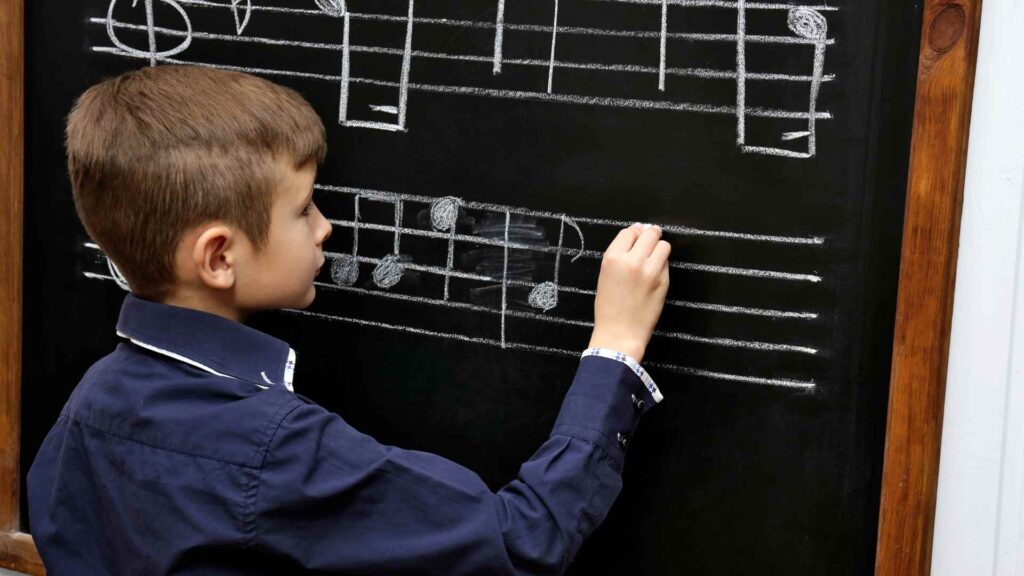
Why Collaboration Matters
- Bonding: Working on songs together builds meaningful connections between child and mentor. It’s a hands-on way to listen, learn, and grow as a team.
- Confidence Building: Encouraging kids to sing or suggest ideas helps them realize their voices matter—literally and figuratively.
- Self-Discovery: Children often surprise themselves with the ideas they create. By letting them take the lead, you encourage them to discover their unique style and identity.
Magic Moments to Treasure
- Playful Brainstorming: Kids can brainstorm silly topics, funny rhymes, or imaginative scenarios for lyrics.
- Experimenting with Sound: Using everyday objects—like tapping spoons on a table or humming into a cardboard tube—can spark endless inspiration.
- Emotional Release: Music offers a safe space for children to express worries, joys, and uncertainties. Turning a tough day into a heartfelt melody can be transformative.
Tips for Making Songwriting Fun
- Embrace Spontaneity: If you see a child humming a random tune, seize that moment. Encourage them to sing out loud and build upon the melody together.
- Celebrate Imperfections: Mistakes are stepping stones to great ideas. Let go of the pressure to create the “perfect” song and celebrate every attempt.
- Use Positive Language: Replace “That sounds weird” with “I’ve never heard that before—tell me more!” so children stay motivated.
Turn songwriting into a playful adventure. Encourage quirky rhythms, silly lyrics, or unexpected rhymes. Children thrive when they feel free to invent and explore.
If they sing about purple clouds or dinosaur bananas, lean into the fantasy! Music is about liberation, discovery, and mirroring a child’s perspective on the world. When you share the joy of creativity, you amplify their confidence and sense of possibility.
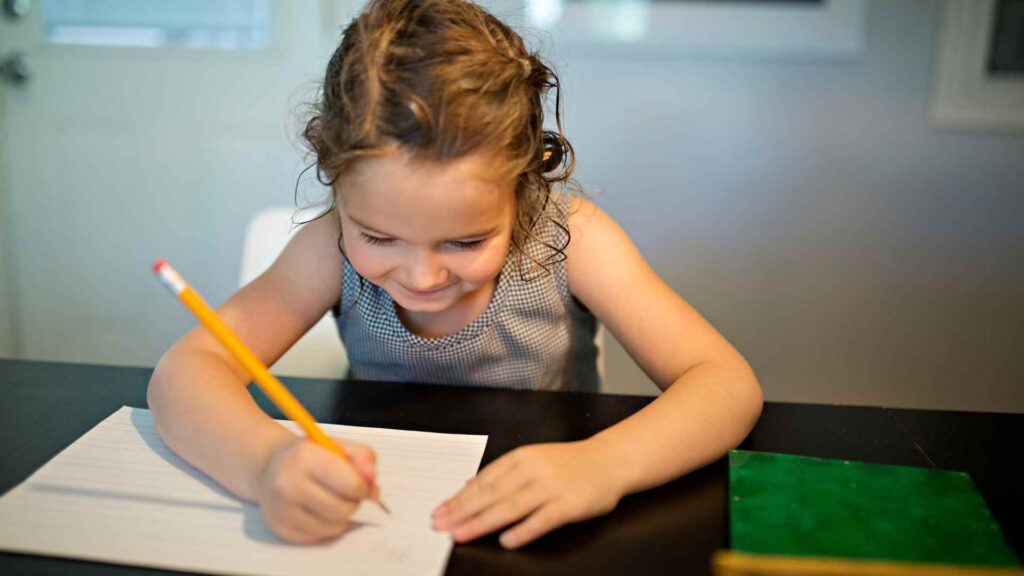
The Basics of Music Theory for Kids
Introducing children to music theory can feel daunting, but it doesn’t have to be. Think of theory as a playground of sounds and ideas rather than a set of strict rules.
By breaking down essential components—like melody, rhythm, and harmony—you empower kids to explore music with curiosity and creativity.
Melody and Notes
- Building Blocks of Sound: Start by explaining that notes are just musical “letters.” Show them a piano keyboard or a xylophone with labeled keys to visualize the distance between each note.
- Singing Names of Notes: Try do-re-mi, or use simple letter names (A, B, C, etc.). Turn it into a game: challenge kids to sing “do” higher or lower to get a feel for pitch changes.
- Melodic Patterns: Encourage children to invent a short, repeating pattern—like do-re-mi. Ask them to shift it higher or lower, so they hear how the pitch changes the mood.
Rhythm and Timing
- Clapping Beats: Nothing is simpler than clapping to internalize rhythm. Have kids clap or stomp in time with music.
- Fun Instruments: Hand out shakers, small drums, or even homemade percussion (like tapping pencils on the table). Emphasize that feeling the pulse of the music is key.
- Counting Exercises: Teach them to count to four with each beat: “1-2-3-4,” repeating to help them feel the loop of a measure.
Harmony and Chords
- Major vs. Minor: Let kids hear the difference. A major chord might evoke bright, happy feelings, while a minor chord can feel more somber or mysterious.
- Simple Chords: Show them on piano or guitar. Even a basic three-chord progression (like C-F-G on piano) can open up a world of possibilities.
- Vocal Harmonies: Encourage kids to sing a melody while you sing a harmony. Show them how layering voices creates a richer sound.
Making Theory Kid-Friendly
Use visual aids, such as colored note flashcards, to represent each musical note or chord. Include stickers, fun shapes, or drawings of animals for younger kids.
The more interactive and colorful your approach, the less intimidating music theory becomes. Encourage them to draw pictures that represent the sound of each chord, or assign an emotion or character to a particular scale.
Practical Applications
- DIY Song Sketches: Have children pick a simple chord progression, then sing or hum a melody over it.
- Rhythm Challenges: Alternate between clapping, tapping, or stomping in different rhythms to understand quarter notes, eighth notes, or syncopation.
- Matching Emotions to Music: Ask them to compose a “happy” melody and compare it to a “sad” melody. Notice how one might use major chords and a brisk tempo, while the other might rely on slower rhythms and minor chords.
By presenting the basics of music theory in an engaging, playful manner, you give kids the freedom to experiment and create.
When young minds connect these fundamental building blocks, songwriting becomes an accessible, expressive art form. Ultimately, music theory isn’t about memorizing facts and rules; it’s about laying the groundwork for free-flowing creativity.
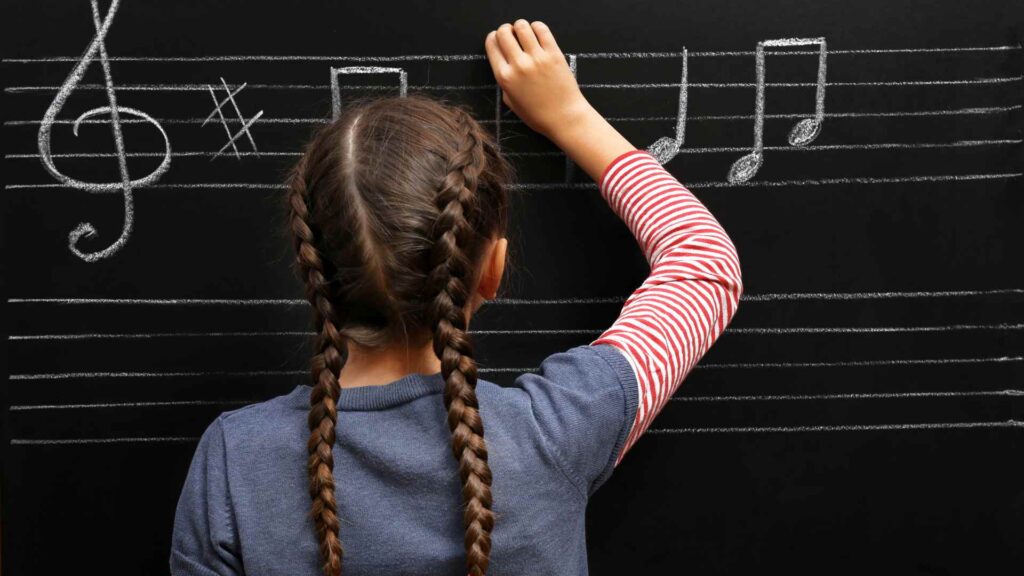
Setting Up a Fun Songwriting Session
A well-structured environment can turn a simple songwriting session into a magical, memorable moment. Kids thrive when given the right balance of freedom and guidance.
From choosing a cozy location to deciding on the instruments and writing materials, every detail can spark creative energy.
The Perfect Space
- Comfy and Inviting: Whether it’s a living room floor with cushions or a classroom corner with beanbags, create a welcoming setting.
- Minimal Distractions: Turn off the TV and minimize device usage, so everyone can focus on making music.
- Inspirational Décor: Hang posters of their favorite musicians, or add bright, musical-themed artwork to inspire them.
Essential Tools
- Instrument Variety: Guitars, keyboards, or small percussion instruments like shakers or tambourines. If you don’t have “real” instruments, improvise with pots and pans or plastic cups.
- Lyric Writing Materials: Keep a whiteboard, large sheets of paper, or a chalkboard handy to jot down ideas. Stickers and colorful markers add an element of fun.
- Recording Devices: Use a phone or a simple recording app to capture new melodies. Children love hearing their own voices played back.
Guiding the Session
- Warm-Up Games: Start by singing a well-known tune or clapping together to get comfortable.
- Brainstorm Themes: Let kids choose a theme—whether it’s about friendship, a favorite animal, or a silly dream. Encourage them to share words or phrases related to that theme.
- Divide and Conquer: Split the session into smaller steps: first come up with a chorus, then build the verses, and finally add a bridge or ending.
- Melody Exploration: Invite children to hum or sing short melodies. Record them, replay, and ask which ones they like best.
- Lyric Crafting: Write down all suggestions, even the silly ones, and piece them together into a cohesive story or message.
Encouraging Group Dynamics
If you’re working with multiple kids, assign roles to keep everyone engaged.
- Idea Master: Writes down or draws out all suggestions.
- Melody Maker: Hums, sings, or plays potential melodic lines.
- Rhythm Captain: Figures out the best beat or tempo for the song.
- Lyric Leader: Helps arrange words into a sensible sequence.
Rotating these roles can help each child feel valued and excited to contribute. Encourage them to cheer each other on, and remember to praise any effort, no matter how big or small.
This approach fosters teamwork while reinforcing the concept that everyone’s input matters in creating something beautiful.
By taking a thoughtful approach to setting up your songwriting session, you’ll help kids feel safe, inspired, and eager to explore. When they see that their ideas are welcomed and respected, the songwriting process becomes an opportunity for growth, self-expression, and, most importantly, fun.
Encouraging Creativity and Self-Expression
Songwriting offers a platform for kids to express emotions, explore identities, and stretch their imaginations.
By celebrating mistakes and championing their unique voices, you empower them to keep experimenting. The ultimate goal is to cultivate a free space where creativity flourishes, unburdened by perfectionism.
Promoting an Open Mindset
- Yes, and…: Borrow this strategy from improv theater. Instead of shutting down ideas with “No,” build on them with “Yes, and….” This nurtures positivity and forward momentum.
- Embrace the Quirky: If a child proposes a line about a dancing cactus or a rapping dinosaur, see where it leads. Surprise elements can make a song unforgettable.
- Break the Rules (Tastefully): Once kids understand basic musical concepts, encourage them to bend or break those “rules” in search of new sounds.
Identifying Each Child’s Strength
- The Natural Storyteller: Some kids shine brightest when weaving stories into lyrics. Give them space to paint vivid images or spin fantastical tales.
- The Melody Maven: Others might have a knack for humming catchy tunes. Let them steer the melodic direction.
- The Rhythmic Rocker: Some kids have a gift for tapping out engaging rhythms or beatboxing. Encourage them to lay down the song’s pulse.
Overcoming Creative Blocks
- Brainstorm Breaks: If kids get stuck, take a brief pause. Stretch, jump, or dance to reinvigorate their energy.
- Musical Prompts: Play a short piece of instrumental music and ask them to describe how it makes them feel. Use that emotion to spark new ideas.
- Visualization: Suggest that children close their eyes and imagine a scene—on a beach, flying in the sky, or in a magical forest—and describe it through words or melodies.
The Importance of Mistakes
Mistakes aren’t the end of creativity; they’re often the beginning. When a child hits a wrong note, highlight how that note can lead to an unexpected chord progression.
If a lyric feels awkward, rework it until it resonates. Celebrate every attempt, because learning to pivot and adapt is crucial to nurturing a resilient creative spirit.
Collaboration and Performance
Once you’ve written a song (or a collection of songs) with kids, the next exciting step is to share that musical creation with others.
Collaboration and performance can take many shapes—from small family gatherings to school showcases or even social media posts.
Whatever the scale, performing helps children develop communication skills, teamwork, and a sense of pride in their accomplishments.
Collaborating with Peers
- Team Writing: Pair kids up in small groups to refine lyrics, melodies, or harmonies. Each child brings a unique perspective, making the song richer.
- Instrumental Roles: Distribute instruments—real or homemade—so each participant feels like part of the “band.”
- Rehearsal Routines: Practice fosters coordination and confidence. Encourage kids to respect each other’s contributions and offer constructive feedback.
Performance Preparation
- Stage Setup: Even if it’s just a living room performance, arrange chairs and a “stage area” so children can feel like true performers.
- Dress Rehearsals: Let them wear fun costumes or themed outfits to tie in with the song’s theme. This playful approach fuels excitement.
- Microphone Fun: If you have a simple microphone or karaoke machine, let them practice speaking into it. Learning stage presence can be thrilling at a young age.
Dealing with Stage Fright
- Supportive Encouragement: Remind children that everyone in the audience wants them to succeed.
- Focus on the Fun: Emphasize that mistakes or stumbles are part of the experience. Laughing them off can lighten the mood for everyone.
- Team Solidarity: If one child forgets a line, others can step in to help, reinforcing the value of collaboration.
Live vs. Virtual Performances
In today’s digital world, you can celebrate these songs beyond a physical audience.
- Live Streams or Recordings: Family members who live far away can watch or listen online.
- Social Media Showcases: With parental guidance, posting a short snippet can build a sense of community and positive feedback.
- Community Events: Explore local open mics or children’s talent shows, which offer valuable experience and exposure.
Showcasing new music is about more than applause; it’s a boost in self-esteem, a lesson in teamwork, and a chance for kids to see their ideas resonate with others.
By emphasizing collaboration, you teach them that music-making is an inclusive adventure. It’s an opportunity for peers, siblings, and friends to unite under a common goal: creating something magical and sharing it with the world.
And that moment—when the last note fades and applause starts—reminds them that their voices truly matter.
Resources and Next Steps
As children grow in their musical journeys, offering them access to quality resources can help refine their talents and inspire further exploration.
From online platforms to community events, there are countless ways to continue nurturing their passion for songwriting.
Online Platforms and Apps
- Kid-Friendly Music Apps: Tools like GarageBand or Chrome Music Lab allow young composers to experiment with beats, melodies, and sounds.
- Educational Websites: Look for sites featuring tutorials on basic chord progressions, beginner instrument lessons, or lyric-writing tips.
- Virtual Collaboration: Older kids might enjoy connecting with friends to compose together online, using shared docs or video calls.
Books and Songwriting Guides
- Age-Appropriate Manuals: Choose resources that break down music theory or lyric writing in kid-friendly language.
- Picture Books on Music: For younger kids, whimsical picture books about famous composers or fictional musical adventures can spark inspiration.
- Lyric Workbooks: Printable PDF workbooks can help children organize rhymes, themes, and structure for their songs.
Local Community and Classes
- Music Schools or Workshops: Check local music schools or youth centers. Many offer short-term courses or group classes in songwriting, instrument lessons, or choir.
- Songwriting Clubs: Some communities or schools have after-school clubs dedicated to writing, composing, or performing music.
- Library Events: Public libraries often host free musical storytimes or songwriting sessions that cater to different age groups.
Recording and Sharing
- Simple Home Studios: A basic setup can include a phone or tablet, a small microphone, and free editing software. Encourage kids to record and listen back to their creations.
- Online Portfolios: For older kids, platforms like SoundCloud (with parental guidance) allow them to share their work and get feedback.
- Physical Copies: Burn CDs or create USB drives of their songs as keepsakes or gifts for family members.
Cultivating Long-Term Growth
Keep the momentum going by consistently setting small, achievable goals. For instance:
- Write One New Song per Month: Even a short, 30-second tune counts.
- Perform for Friends: Encourage mini-concerts at birthday parties or family get-togethers.
- Seek Mentors: If possible, connect kids with local musicians, teachers, or older students who can guide them.
By connecting children to reliable resources and next steps, you show them that the joy of writing music doesn’t have to end when a single session wraps up. Instead, each composition can be a stepping stone to deeper exploration.
The world of music is vast and inviting, and every child deserves the chance to discover its infinite possibilities.
Conclusion
Songwriting with kids brings pure delight, nurtures creative courage, and sparks a love for music that can last a lifetime.
From joyful first melodies to starry-eyed performances, every step is an invitation to grow, bond, and dream. Hand them the microphone, and watch their confidence and imagination soar!
